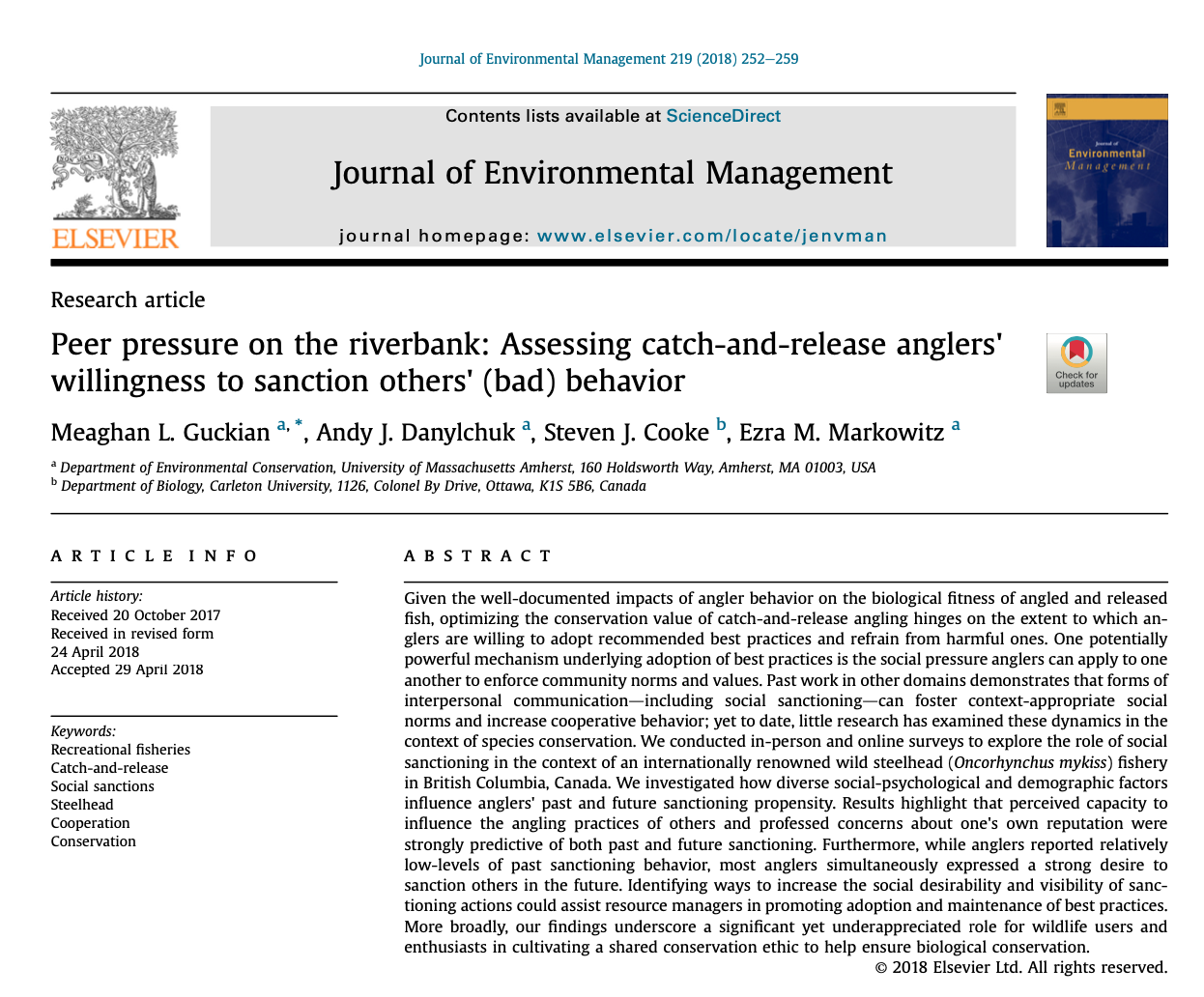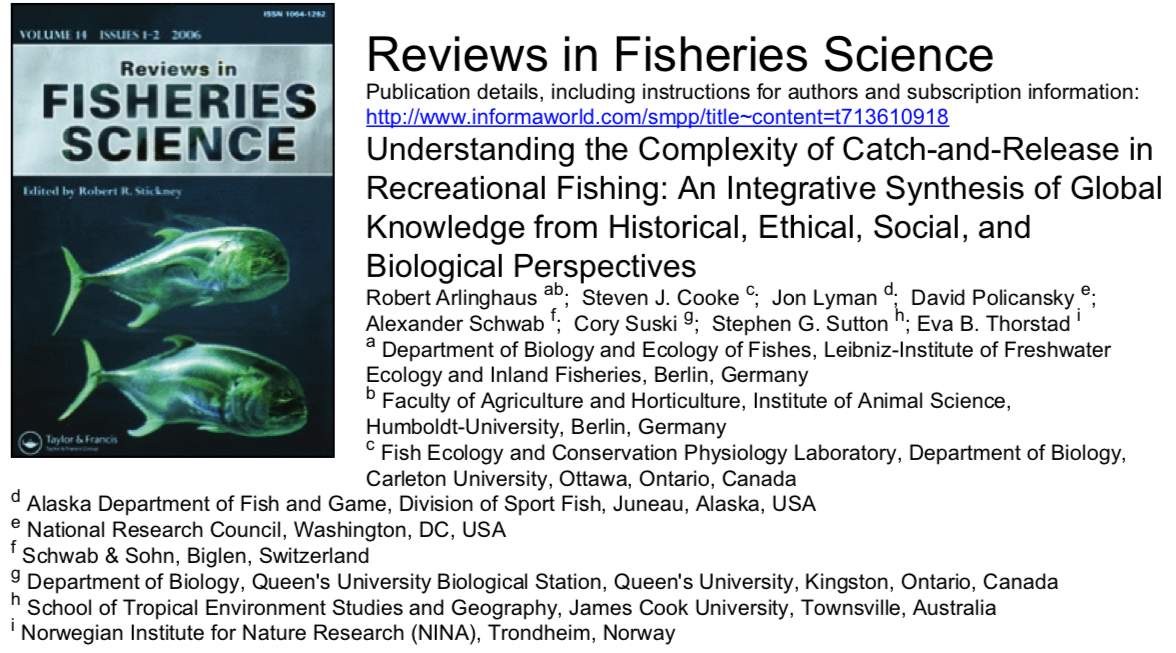Viewing entries in
Science
Consequences of catch-and-release angling on the physiology, behaviour and survival of wild steelhead Oncorhynchus mykiss in the Bulkley River, British Columbia
W.M. Twardek, T.O. Gagne, L.K. Elmer, S.J. Cooke, M.C. Beere, A.J. Danylchuk
Steelhead, the anadromous form of rainbow trout (Oncorhynchus mykiss), is one of the most coveted re- creationally targeted salmonids worldwide, and catch-and-release (C&R) is commonly used as a conservation strategy to protect wild stocks. Nevertheless, little research has examined how wild steelhead respond to capture and handling. During a summer-run recreational fishery on the Bulkley River in British Columbia, we used non- lethal blood sampling and radio telemetry to assess the physiological stress response, post-release behaviour, and survival of wild steelhead exposed to either 0 s, 10 s, or 30 s of air exposure, over a range of water temperatures, fight times, and landing methods. Steelhead that were air exposed following landing had greater reflex im- pairment and moved further downstream immediately following release than fish kept in the water, though there was no observed difference in movement two weeks after capture. Overall, angled fish had significantly greater blood lactate levels than baseline levels (obtained from a subsample of fish dip netted from the river) suggesting a general stress response to angling and handling. Regardless of air exposure treatment, water temperature was positively associated with blood lactate and negatively associated with blood pH. Other variables such as fish body size (mm) and fight time (s) had little influence on any of the physiological or behavioural variables. Estimated 3-day survival of steelhead was 95.5%, with deep-hooking as the primary source of mortality. Over- winter mortality of caught-and-released fish was estimated at 10.5%, with an estimated total pre-spawn mor- tality of 15.0%. This study is the first to evaluate the factors that influence C&R outcomes in wild steelhead in a recreational fishery. Findings suggest that steelhead anglers should limit air exposure to less than 10 s, and that anglers should be cautious (minimize handling and air exposure) when water temperatures are warmer.
At Keepemwet Fishing we believe that communication and knowledge sharing between the fisheries science and recreational angling communities is a two way street. For example, anglers can learn more about fisheries science, and scientist can learn about the issues that are important to anglers and this can help inform their research. We need this type of dialogue and interaction to make sure that catch-and-release is effective. Scientists communicate and share their work and ideas through the publication of peer-reviewed articles in scientific journals, and so, here is our first contribution on Keepemwet Fishing to science literature.
"There is a growing body of catch-and-release (C&R) science showing that adjusting the way fish are caught, handled, and released can reduce impacts on individuals and populations. However, a major caveat is that C&R will be a more effective conservation tool if best practice guidelines stemming from the science are understood, embraced, and adopted by recreational anglers. In recognition of this, Keepemwet Fishing (KWF) has emerged as a nonpartisan movement to provide simple, clear, and accurate C&R guidelines that transcend species and subcultures within the recreational angling community". Full report here.
Understanding the Complexity of Catch-and-Release in
Recreational Fishing: An Integrative Synthesis of Global
Knowledge from Historical, Ethical, Social, and
Biological Perspectives
Most research on catch-and-release (C&R) in recreational fishing has been conducted
from a disciplinary angle focusing on the biological sciences and the study of hooking
mortality after release. This hampers understanding of the complex and multifaceted
nature of C&R. In the present synopsis, we develop an integrative perspective on C&R
by drawing on historical, philosophical, socio-psychological, biological, and managerial
insights and perspectives. Such a perspective is helpful for a variety of reasons,
such as 1) improving the science supporting successful fisheries management and conservation,
2) facilitating dialogue between managers, anglers, and other stakeholders,
3) minimizing conflict potentials, and 4) paving the path toward sustainable recreational
fisheries management. The present work highlights the array of cultural, institutional,
psychological, and biological factors and dimensions involved in C&R. Progress toward
successful treatment of C&R might be enhanced by acknowledging the complexity
inherent in C&R recreational fishing.
The mahseer (Tor spp.) of India are a group of potamodromous cyprinids currently facing numerous challenges in their native ranges including overfishing, pollution, and hydropower development. As a result of such challenges, four of the seven Indian species of Tor have been listed as ‘Endangered’ on the IUCN Red List, including two of the most popular recreationally fished species, Tor khudree and Tor putitora.Stakeholders in the mahseer recreational fishery may serve as an ally for this group of iconic fishes, fostering aquatic stewardship and providing livelihood alternatives for poachers. Yet, information regardings pecies-specific responses to recreational fishing practices is lacking and a 2009 decree equating fishing with hunting in the Indian Wildlife Protection Act (1972) has since 2011 effectively banned angling within protected areas and rendered the future of mahseer recreational fisheries elsewhere uncertain. Read More.
Golden dorado (Salminus brasiliensis) is increasing in popularity as a target of recreational anglers practicing catch-and-release (C&R) in northern Argentina and bordering countries, however science-based best practices have yet to be developed for this iconic freshwater game fish. We assessed the consequences of C&R on golden dorado captured by anglers on the Juramento River, in Salta, Argentina. Read More.
In August of 2015 recreational fisheries researchers, managers,and stakeholders assembled at the American Fisheries Society Annual Meeting in Portland, Oregon to discuss the current state of catch-and-release angling science and practice in the 21st century. Beyond providing a venue for participants to share the latest science on the topic, there was a strong emphasis on understanding how the science relates to or could inform practice. Read More.
Catch-and-release angling is an increasingly popular conservation strategy employed by anglers voluntarily or to comply with management regulations, but associated injuries, stress and behavioural impairment can cause post-release mortality or fitness impairments. Because the fate of released fish is primarily determined by angler behaviour, employing ‘best angling practices’ is critical for sustain-able recreational fisheries. While basic tenants of best practices are well established, anglers employ adiversity of tactics for a range of fish species, thus it is important to balance science-based best practices with the realities of dynamic angler behaviour. Here we describe how certain tools and tactics can be integrated into recreational fishing practices to marry best angling practices with the realities of angling. While the effects of angling practices vary considerably across contexts and conditions, we also outline available methods for assessing fish condition by examining physical injuries and reflexes, which enable recreational anglers to make educated real-time decisions related to angling practices, as well as when, where, and whether to release captured fish based on their probability of survival. In cases where fish are in poor condition, there are recovery tactics available that can improve survival, although this is among the most understudied aspects of angling practices. Read More.
"The recreational angling community is comprised of diverse stakeholders, including the trade sector responsible for the manufacturing, distribution, and sales of tackle, boats, and clothing, angler-based travel, revenue-generating popular media, and angling services. Through marketing and promotion, fishing companies compete for customers by convincing anglers as to what success means when they go fishing. If the angling trade can influence the social norms in the recreational angling community, then this could hold true for norms related to the conservation of recreationally targeted fishes and their habitats." Read More
The objective of catch-and-release angling is for the fish to survive with minimal fitness consequences. However, fish survival can be compromised by a number of factors, especially anatomical hooking location. To evaluate whether hook type or bait influence hooking outcomes, we tested different combinations of hook (treble or single siwash hooks) and bait (hook tipped with worm or no worm) while angling for brook trout (Salvelinus fontinalis) with inline spinner-style fishing lures. Read More.
Recreational catch-and-release angling is an important tool for managing fish stocks. As recreational fishing is often a culturally or community-based activity, many anglers look to local grassroots and other non-government organizations (NGOs) as a source of information regarding their angling practices. Read More.
The effects of cold shock on fish have rarely been assessed in sub-tropical regions despite the fact that such events
can occur as a result of upwelling, storms, or other climactic events that are expected to increase as a result of
global environmental change. Here, the sub-lethal physiological and behavioural consequences of cold shock
on bonefish... Read More.
Just released study involving Keepemwet Fishing Science Advisor Dr. Andy Danylchuk.
"Catch-and-release angling is an increasingly popular conservation strategy employed by anglers vol-untarily or to comply with management regulations, but associated injuries, stress and behaviouralimpairment can cause post-release mortality or fitness impairments. Because the fate of released fishis primarily determined by angler behaviour, employing ‘best angling practices’ is critical for sustain-able recreational fisheries." Read more.
A great paper by Katrina V. Cook, Robert J. Lennox, Scott G. Hinch, and Steven J. Cooke about how much air exposure is too much.


















